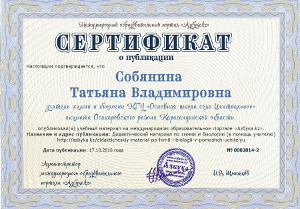Developing communication skills in English lessons
|
Есимканова Алтын Даулетовна учитель английского языка, КГУ СОШ № 10, 1 категория высшего уровня, стаж — 16 лет г.Караганда
|
Развитие коммуникативных навыков на уроках английского языка

Of all the four skills: listening, speaking, reading and writing, speaking seems intuitively the most important. This, explain why so many language learners are very interested in the speaking skill. Most English learners feel that they need more conversation practice. In fact, over the years I’ve noticed that the number one requested skill by students is conversation practice. I think these points clearly to the fact that students need English to communicate first and foremost. Grammar, writing and other skills are all very important, but in the students’ minds conversation is the most important. Communicative teaching is often organized in the three-phase framework. Three-phase framework means subdivision of the teaching process into three phases: pre-activity, while-activity and post activity. Pre-activity is organized to arouse interest in the learners towards the main task, to motivate performance, to activate in learners their prior knowledge and to prepare them for the language that can be necessary to perform the main task. While-activity is organized as oral or written communication and is based on engaging the learners in the communicative tasks. Post-activity is reflection on the ideas and language that was produced during the main activity. This phase also includes additional language drill and integration with other skills.
Integrated task
• Give a rationale for communicative language teaching
• Illustrate the tasks for teaching pronunciation, grammar and lexis (indicate the source)
• Describe the tasks for teaching speaking and writing, listening and reading
• Work out a three-phase framework for any one of the tasks
The process of communication is characterized with communicative strategies of achieving a goal through communication Success of communication depends very much on the knowledge of successful strategies chosen by the speakers. Successful strategies are known as the «four maxims» of good communication. These maxims include quality, quantity, relevance and manner. The four maxims of successful communication can be used in teaching how to communicate effectively.
Communicative techniques fall down into a number of groups:
A. Language arts are oriented towards a communicative task but are not «communicative» in them.
B. Language for a purpose is what the learners might need to learn how to request information, how to change somebody’s behavior or train of thought, how to co-ordinate efforts in a team, how to express one’s emotions etc.
C. Communicative games can be alternative communicative techniques with a challenge, rules, procedure and winners.
D. Personal language use develops in learners the skill of expressing one’s own attitudes and values.
E. Theatre art develops communicative skills in simulations such as role-plays.
F. Debating society teaches problem-solving skills.
Information gap is organized to promote speaking activities. Information gap is a situation when a participant or a group possesses the information, which others do not have, while others command the information that the other party is missing. E. g. a student in a pair with the other student might have the train timetable for odd numbers, while her partner might have the train timetable for even numbers. Their task is to use communication for finding out complete information on how the train runs. Information gap can take the format of an opinion gap when the participants differ in their opinions. The gap is filled in the course of active communication.
Any activity with an information gap can be turned into a communicative game if there are rules to name the winner. Information gap is a frequent technique used in order to organize a communicative game. E. g. you have new neighbors. They can tell you about themselves only what is given on their role cards. Try to guess their professions. Ask any questions. Direct questions about professions are excluded.
A popular speaking activity is reading from cues. It is organized when the participants write information about themselves on sticky labels in the form of separate words, dates, names etc. Other students ask questions trying to find as much as possible about the person, To achieve this goal they have to think first what a date on the sticky label might mean and ask a question like «Were you married in 1991?», «May be you got your first job in 1991?» etc.
Jig-saw reading activity is organized most often with the texts that are meant for reading or listening («jig-saw» reading and «jig-saw» listening). A text is divided into several parts. Every participant has access to only one part of the oral or written text. They ask each other questions and provide information to pool the parts of the text together and to know the contents of the whole text. Another variant is a jig-saw listening when each participant or a small group listens to only some information as part of the whole. These pieces can be brought together only in the course of active communication efforts.
Productive skills of speaking and writing are developed in simulations. A simulation means that an episode of the real world is reproduced in the classroom environment in the form of the role-play, discussion (problem solving), piece of writing or a project work.
Unfortunately, teaching conversational skills is much more challenging that teaching grammar.
When employing role-plays, debates, topic discussions, etc., I have noticed that some students are often timid in expressing their viewpoints. This seems due to a number of reasons.
• Students don’t have an opinion on the subject
• Students have an opinion, but are worried about what the other students might say or think
• Students have an opinion, but don’t feel they can say exactly what they mean
• Students begin giving their opinion, but want to state it in the same eloquent manner that they are capable of in the native language.
Having been assigned roles, opinions and points of view that they do not necessarily share, students are freed from having to express their own opinions. Therefore, they can focus on expressing themselves well in English. In this way, students tend to concentrate more on production skills, and less on factual content. They also are less likely to insist on literal translations from their mother tongue.
Implementing this approach can begin slowly by providing students with short role plays using cue cards. Once students become comfortable with target structures and representing differing points of view, classes can move onto more elaborated exercises such as debates and group decision making activities. This approach bears fruit especially when debating opposing points of view. As students inherently do not agree with the view they represent, they are freed from having to invest emotionally in the statements they make. More importantly, from a pragmatic point of view, students tend to focus more on correct function and structure when they do not become too emotionally involved in what they are saying.
Of course, this is not to say that students should not express their own opinions. After all, when students go out into the «real» world they will want to say what they mean. However, taking out the personal investment factor can help students first become more confident in using English. Once this confidence is gained, students — especially timid students — will be more self-assured when expressing their own points of view. Debates in class can help English learners practice a wide range of functions including agreeing and disagreeing, negotiating, collaboration with other students, and so on. Often students need help with ideas and that’s where this lesson plan can help. Students support opinions that are not necessarily their own during debates can help improve students’ fluency. In this manner, students pragmatically focus on correct production skills in conversation rather than striving to «win» the argument
References
1.Canale, M., and M. Swain. 1980. «Theoretical bases of communicative approaches to second language teaching and testing». Applied Linguistics 1: 1-47
2.Roth. I. 1994. Introduction to Psychology. Volume 1. The Open University
3.Savignon, S. 1983. Communicative Competence: Theory and Classroom Practice. Mass.
4.Berns, M. 1990. Contexts of Competence. Social and Cultural Considerations in Communicative Language Teaching. N. Y.
5.Madeline, E. 1996. Understanding Second Language Learning Difficulties. Sage Publications
6. Pollak A. Communicative strategies at work. NJ 1995
- 19876 просмотров


.webp)






.webp)
